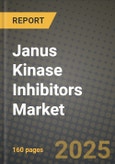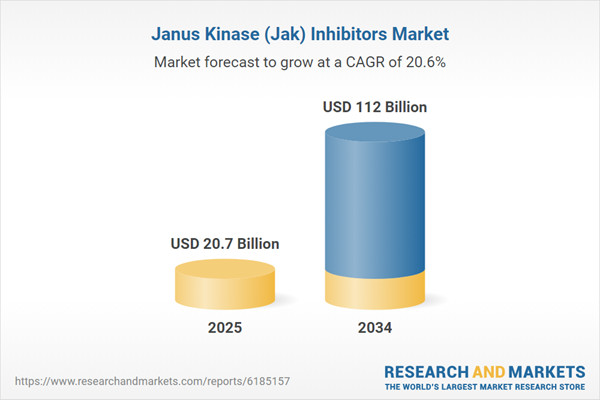The Janus Kinase (JAK) Inhibitors Market is centered around a class of targeted therapies that block specific enzymes involved in inflammatory pathways, offering an alternative to biologics for treating autoimmune and inflammatory diseases such as rheumatoid arthritis, psoriasis, ulcerative colitis, and atopic dermatitis. These oral small-molecule drugs offer convenience, fast onset, and broad applicability across indications, making them an attractive option for both patients and clinicians. Market growth is fueled by rising global autoimmune disease prevalence, increased clinical adoption, and robust pharmaceutical pipelines. However, regulatory scrutiny over safety profiles, particularly related to cardiovascular and malignancy risks, continues to shape prescribing behavior and product labeling.
The JAK inhibitors market witnessed both expansion and realignment. Pfizer’s Xeljanz and AbbVie’s Rinvoq remained market leaders, but regulatory agencies like the FDA and EMA introduced updated boxed warnings, reinforcing safety monitoring. New entrants such as BMS’s Sotyktu and Eli Lilly’s Olumiant gained traction in dermatology and alopecia areata, respectively. Clinical trials explored JAK inhibitors for new indications, including vitiligo and Crohn’s disease. Pharmaceutical companies worked to differentiate molecules based on selectivity profiles, with TYK2 inhibitors emerging as a potential safer subclass. Market access dynamics were influenced by payer scrutiny, requiring manufacturers to strengthen real-world evidence of benefit-risk balance and cost-effectiveness.
The JAK inhibitors market is expected to grow through innovation in selectivity, extended-release formulations, and combination therapy strategies. TYK2 inhibitors will likely gain broader approval, shifting market dynamics toward agents with reduced immunosuppressive risks. Pharmaceutical players will invest in biomarker-driven patient stratification to improve efficacy and safety outcomes. Expansion into new autoimmune and dermatological indications will diversify portfolios. Post-marketing surveillance, AI-driven pharmacovigilance, and long-term data collection will play a key role in maintaining regulatory confidence and guiding clinical use. As patients and providers seek balance between convenience, efficacy, and safety, the next generation of JAK inhibitors will reshape chronic inflammation care.
Key Insights: Janus Kinase (Jak) Inhibitors Market
- The analyst highlights the growing interest in TYK2-selective inhibitors as a safer alternative to traditional JAK inhibitors, particularly for dermatological applications with a reduced risk of immunosuppressive side effects.
- Label expansion into dermatology and alopecia areata is trending, with several JAK inhibitors gaining regulatory approval or fast-track designation for inflammatory skin conditions and hair loss disorders.
- According to the analyst, personalized medicine strategies involving biomarker-driven patient selection are trending, helping to optimize therapy outcomes and reduce adverse events in autoimmune disease treatment.
- Digital pharmacovigilance tools and AI-based safety signal detection are trending in post-marketing surveillance, improving long-term risk monitoring and compliance with evolving regulatory requirements.
- Combination therapies that pair JAK inhibitors with topical agents or biologics are being explored to enhance treatment outcomes in complex autoimmune disorders, opening new clinical research avenues.
- The analyst identifies the rising global prevalence of autoimmune diseases, such as rheumatoid arthritis and ulcerative colitis, as a key driver of sustained demand for novel oral immunomodulatory therapies like JAK inhibitors.
- Convenience of oral administration compared to injectable biologics is encouraging patient and provider preference for JAK inhibitors in chronic disease management, says the analyst.
- The analyst notes that robust R&D pipelines and high unmet needs in dermatology and gastroenterology are accelerating the development and approval of next-generation JAK and TYK2 inhibitors.
- Increasing awareness among clinicians regarding differential selectivity and safety profiles is supporting greater adoption of newer molecules perceived to offer more favorable benefit-risk ratios.
- The analyst highlights heightened regulatory scrutiny, including updated black-box warnings and prescribing limitations, as a major challenge impacting physician confidence and market uptake of JAK inhibitors.
- According to the analyst, payer resistance and high therapy costs can hinder patient access, especially when safety concerns prompt stricter formulary placement and require extensive prior authorization processes.
Janus Kinase (Jak) Inhibitors Market Segmentation
By Inhibitors Type
- Ruxolitinib
- Tofacitinib
- Oclacitinib
- Baricitinib
- Peficitinib
- Other Inhibitor Types
By Mode Of Administration
- Injectable
- Oral
- Other Modes Of Administration
By Distribution Channel
- Hospital pharmacies
- Retail pharmacies
- Online pharmacies
By Application
- Autoimmune Disorders
- Oncology
- Inflammatory Disorders
- Metabolic Disorders
Key Companies Analysed
- Pfizer Inc.
- Merck & Co. Inc.
- AbbVie Inc.
- Novartis AG
- Sanofi SA
- Bristol Myers Squibb Co.
- GSK Plc.
- Takeda Pharmaceutical Company Ltd.
- Eli Lilly and Co.
- Gilead Sciences Inc.
- Boehringer Ingelheim Group
- Teva Pharmaceutical Industries Ltd.
- Astellas Pharma Inc.
- AstraZeneca PLC
- Mitsubishi Tanabe Pharma Corporation
- Incyte Corporation
- Kyowa Hakko Kirin Co. Ltd.
- Galapagos NV
- Sierra Oncology Inc.
- Dizal Pharmaceutical
- Reistone Biopharma Co. Ltd.
- CTI BioPharma Corp.
- Celon Pharma SA
- Theravance Biopharma Inc.
- Aclaris Therapeutics Inc.
- Alexion Pharmaceuticals Inc.
Janus Kinase (Jak) Inhibitors Market Analytics
The report employs rigorous tools, including Porter’s Five Forces, value chain mapping, and scenario-based modeling, to assess supply-demand dynamics. Cross-sector influences from parent, derived, and substitute markets are evaluated to identify risks and opportunities. Trade and pricing analytics provide an up-to-date view of international flows, including leading exporters, importers, and regional price trends.Macroeconomic indicators, policy frameworks such as carbon pricing and energy security strategies, and evolving consumer behavior are considered in forecasting scenarios. Recent deal flows, partnerships, and technology innovations are incorporated to assess their impact on future market performance.
Janus Kinase (Jak) Inhibitors Market Competitive Intelligence
The competitive landscape is mapped through proprietary frameworks, profiling leading companies with details on business models, product portfolios, financial performance, and strategic initiatives. Key developments such as mergers & acquisitions, technology collaborations, investment inflows, and regional expansions are analyzed for their competitive impact. The report also identifies emerging players and innovative startups contributing to market disruption.Regional insights highlight the most promising investment destinations, regulatory landscapes, and evolving partnerships across energy and industrial corridors.
Countries Covered
- North America - Janus Kinase (Jak) Inhibitors market data and outlook to 2034
- United States
- Canada
- Mexico
- Europe - Janus Kinase (Jak) Inhibitors market data and outlook to 2034
- Germany
- United Kingdom
- France
- Italy
- Spain
- BeNeLux
- Russia
- Sweden
- Asia-Pacific - Janus Kinase (Jak) Inhibitors market data and outlook to 2034
- China
- Japan
- India
- South Korea
- Australia
- Indonesia
- Malaysia
- Vietnam
- Middle East and Africa - Janus Kinase (Jak) Inhibitors market data and outlook to 2034
- Saudi Arabia
- South Africa
- Iran
- UAE
- Egypt
- South and Central America - Janus Kinase (Jak) Inhibitors market data and outlook to 2034
- Brazil
- Argentina
- Chile
- Peru
Research Methodology
This study combines primary inputs from industry experts across the Janus Kinase (Jak) Inhibitors value chain with secondary data from associations, government publications, trade databases, and company disclosures. Proprietary modeling techniques, including data triangulation, statistical correlation, and scenario planning, are applied to deliver reliable market sizing and forecasting.Key Questions Addressed
- What is the current and forecast market size of the Janus Kinase (Jak) Inhibitors industry at global, regional, and country levels?
- Which types, applications, and technologies present the highest growth potential?
- How are supply chains adapting to geopolitical and economic shocks?
- What role do policy frameworks, trade flows, and sustainability targets play in shaping demand?
- Who are the leading players, and how are their strategies evolving in the face of global uncertainty?
- Which regional “hotspots” and customer segments will outpace the market, and what go-to-market and partnership models best support entry and expansion?
- Where are the most investable opportunities - across technology roadmaps, sustainability-linked innovation, and M&A - and what is the best segment to invest over the next 3-5 years?
Your Key Takeaways from the Janus Kinase (Jak) Inhibitors Market Report
- Global Janus Kinase (Jak) Inhibitors market size and growth projections (CAGR), 2024-2034
- Impact of Russia-Ukraine, Israel-Palestine, and Hamas conflicts on Janus Kinase (Jak) Inhibitors trade, costs, and supply chains
- Janus Kinase (Jak) Inhibitors market size, share, and outlook across 5 regions and 27 countries, 2023-2034
- Janus Kinase (Jak) Inhibitors market size, CAGR, and market share of key products, applications, and end-user verticals, 2023-2034
- Short- and long-term Janus Kinase (Jak) Inhibitors market trends, drivers, restraints, and opportunities
- Porter’s Five Forces analysis, technological developments, and Janus Kinase (Jak) Inhibitors supply chain analysis
- Janus Kinase (Jak) Inhibitors trade analysis, Janus Kinase (Jak) Inhibitors market price analysis, and Janus Kinase (Jak) Inhibitors supply/demand dynamics
- Profiles of 5 leading companies - overview, key strategies, financials, and products
- Latest Janus Kinase (Jak) Inhibitors market news and developments
Additional Support
With the purchase of this report, you will receive:- An updated PDF report and an MS Excel data workbook containing all market tables and figures for easy analysis.
- 7-day post-sale analyst support for clarifications and in-scope supplementary data, ensuring the deliverable aligns precisely with your requirements.
- Complimentary report update to incorporate the latest available data and the impact of recent market developments.
This product will be delivered within 1-3 business days.
Table of Contents
Companies Mentioned
- Pfizer Inc.
- Merck & Co. Inc.
- AbbVie Inc.
- Novartis AG
- Sanofi SA
- Bristol Myers Squibb Co.
- GSK PLC
- Takeda Pharmaceutical Company Ltd.
- Eli Lilly and Co.
- Gilead Sciences Inc.
- Boehringer Ingelheim Group
- Teva Pharmaceutical Industries Ltd.
- Astellas Pharma Inc.
- AstraZeneca PLC
- Mitsubishi Tanabe Pharma Corporation
- Incyte Corporation
- Kyowa Hakko Kirin Co. Ltd.
- Galapagos NV
- Sierra Oncology Inc.
- Dizal Pharmaceutical
- Reistone Biopharma Co. Ltd.
- CTI BioPharma Corp.
- Celon Pharma SA
- Theravance Biopharma Inc.
- Aclaris Therapeutics Inc.
- Alexion Pharmaceuticals Inc.
Table Information
| Report Attribute | Details |
|---|---|
| No. of Pages | 160 |
| Published | October 2025 |
| Forecast Period | 2025 - 2034 |
| Estimated Market Value ( USD | $ 20.7 Billion |
| Forecasted Market Value ( USD | $ 112 Billion |
| Compound Annual Growth Rate | 20.6% |
| Regions Covered | Global |
| No. of Companies Mentioned | 26 |









